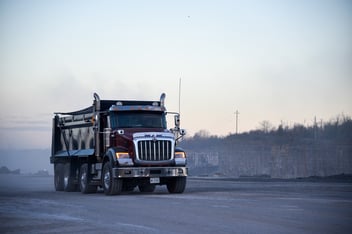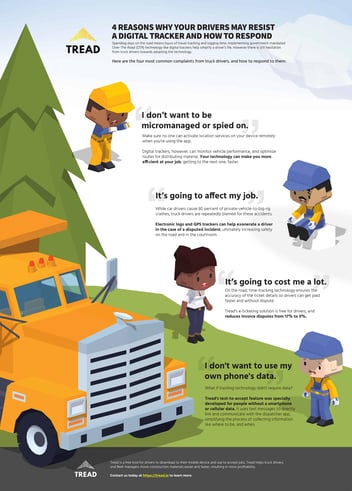9 ways to improve truck driver communication
Effective, efficient truck driver communication is critical to the success of your company. Not only can misunderstandings lead to lost jobs and unhappy customers, but delays linked to poor communication can quickly erode your company’s reputation within the industry.
Great communication can improve morale among your employees and owner-operators, eliminate costly miscommunications, and help mitigate inefficiencies. Communicating better makes everyone happier and better at their job, but it also translates into financial benefits like faster cycle times and controlling your fleet fuel costs.
The good news is, there are a number of easy things you can do to keep miscommunications from getting in the way of your success. Here are nine simple ways to improve communications between your drivers, dispatchers, and customers:
- Get to know your drivers
- Use SMS for driver-dispatcher communications
- Communicate in more than English
- Don’t abandon CB radios
- Eliminate industry jargon
- Never text when you’re angry
- Optimize dispatching with digital solutions
- Use free video chat apps
- Listen to your drivers
1. Get to know your drivers in person
In today’s contactless world, it’s entirely possible to post a trucking job and hire drivers without you and your drivers ever meeting each in person. That makes operations incredibly efficient, but can also make it harder to build positive relationships between operators and dispatchers.
Companies that focus on developing strong working relationships among employees and contractors tend to enjoy better long-term success. Getting to know your drivers helps foster a sense of connection and pride, and that goes a long way towards minimizing problems related to communication.
Save up to 30% in time and cost savings for your dispatching operations. Request a free demo of Tread’s truck dispatch software today.
2. Make the most of SMS solutions
Let’s face it — truck stops, loading docks, and highways are incredibly loud places. That can make clear, two-way conversations using a cell phone or CB radio a real problem. And in many cases, poor communication is worse than no communication at all.
When you need to be absolutely sure that your message is clearly understood, don’t call — send an SMS text instead.
Pro Tip: With Tread, sending dispatch texts to your team is simple, and your drivers can quickly respond by text with “Ok” or “No” manually or by using their hands-free Bluetooth devices, if they prefer. Better yet, your dispatcher can easily track driver responses on Tread’s dispatch app and automatic reminders are sent when your drivers need to take action.
3. Communicate in multiple languages
According to the latest U.S. Census Bureau data, 78% of Americans speak only English at home, which means the other 22% prefer to speak a language other than English.
Using English-only in your truck driver communications may be the norm, but it can also lead to misunderstandings between your drivers and dispatchers. In a perfect world, dispatchers could speak every language that a driver prefers. Until then, technology can help you communicate in multiple languages to be better understood by all.
Pro Tip: With Tread’s in-app English and Spanish support, you can create customized bilingual training videos, and drivers can opt to receive in-app text reminders and support in their choice of English or Spanish.
4. Don’t ditch those CB radios
While CB radios are no longer the essential tools they once were, they’re still a must-have within the trucking industry.
Truckers rely on their CB radio to communicate essential information with other drivers while on the road, whether it’s to chat about their favorite truck stops, pass on critical weather info, or discuss the best routes to avoid accidents and delays. A CB radio can be a lifesaver when traveling through areas with spotty cell phone service, and when your truck drivers need to connect with local police, fire or ambulance.
Pro Tip: Along with helpful new technology, consider including a CB radio in your dispatch toolkit to keep up-to-speed on what’s happening on the road and with your drivers.
5. Cut the jargon
Make sure your communication is clear, concise, and free of any complicated jargon or slang that can be easily misinterpreted. That’s especially true when sending a text, since you can never be 100% certain that your driver will be the only one to read your message.
If you ever played the ‘telephone’ game as a kid, you can appreciate how quickly a simple message can trigger a series of problems for you, your drivers, and your customers. Given the fact that a significant number of truck drivers aren’t native English speakers, using jargon is literally like speaking a foreign language to many operators. Stick to the correct terminology, and when in doubt, double-check to be sure your drivers understand the info they’ve been sent.
6. Don’t send ‘angry’ texts and emails
Never write emotionally-charged texts or emails to your drivers. Not only is this unprofessional, but chances are good that doing so will only serve to amplify whatever the problem or issue is.
When dealing with a conflict, take the time to pick up the phone and talk to your driver. While it can be tempting to simply fire off an angry text message, keep in mind that your message could wind up being shared among all the truck drivers on your team.
Before you hit that ‘send’ button, be sure to read over your message. If it’s not something you’d want broadcast to the entire company, delete it and try again when you’re feeling more calm.
7. Take advantage of digital dispatch and scheduling solutions
Gone are the days of dispatching truck drivers over CB radios, fax machines and endless phone calls, thanks to today’s digital scheduling solutions. The trick is finding a scheduling app or program that’s actually designed to meet the complex needs of the construction, transportation, and logistics industry, rather than one that’s meant to help you organize your kid’s soccer games or book staff to work in a retail environment.
Pro-Tip: With a construction-logistics-focused solution like Tread, you can schedule your drivers with a few quick taps on your keyboard, tablet, or cell phone — in about 30% less time than using other systems. Dispatchers can also set up a customized hire list based on metrics such as availability and assignment status, and collaborate between multiple drivers and dispatchers to develop a seamless schedule in real time.
8. Make use of video chat apps
In 2020, we all became familiar with video conferencing apps like Zoom, Facetime and Google Hangouts. And we largely gained an appreciation for how video conferencing can enhance our personal and professional communications.
Although these apps can never fully replace in-person communications, they can be a great way for your team members to connect with each other, even if they’re on opposite sides of the country.
Let’s face it — life as a trucker can be pretty lonely sometimes, and for many drivers, a quick video chat can be just the moral booster they need.
9. Listen
If you only do one thing to improve communications with your truck drivers, it’s this — simply listen to them.
That can mean taking a phone call from a driver who’s frustrated by a delay at a loading dock, responding quickly to a request for time off, or even being a sounding board for a trucker who’s having a rough day.
Keep in mind that the trucking industry can be incredibly stressful, and your drivers need a healthy way to manage their stress. Simply asking how they’re doing can make all the difference when it comes to improving driver performance, increasing morale and creating a productive, healthy workplace.
Level-up your communication with Tread
Tread is a transportation management software that allows better communication between drivers, dispatchers, and construction companies. Beyond improving communication, Tread gives you real-time operational data and helps streamline your workflows.
Want to learn more? Request a demo to find out how to integrate these simple truck driver communication tips into your operations with the help of Tread.
Read On

Truck Driver Safety Incentive Program: 5 Key Practices
When you’re in charge of a truck fleet, driver safety should be paramount. As demands on truck...

9 truck driver safety meeting topics to cover
Safety doesn’t happen by accident. It is an initiative that requires a commitment to education and...

4 Reasons Why Your Drivers May Resist a Digital Tracker
Truck drivers, on average, spend upwards of 300 days per year on the road and are required to log...

